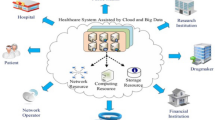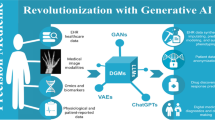Abstract
Advances of computational sciences over the last decades have enabled the introduction of novel methodological approaches in biomedical research. Acquiring extensive and comprehensive data about a research subject and subsequently extracting significant information has opened new possibilities in gaining insight into biological and medical processes. This so-called big data approach has recently found entrance into medical imaging and numerous epidemiological studies have been implementing advanced imaging to identify imaging biomarkers that provide information about physiological processes, including normal development and aging but also on the development of pathological disease states. The purpose of this article is to present existing epidemiological imaging studies and to discuss opportunities, methodological and organizational aspects, and challenges that population imaging poses to the field of big data research.

Similar content being viewed by others
References
Wolfe KH, Li WH (2003) Molecular evolution meets the genomics revolution. Nat Genet 33(Suppl):255–265
Bamberg F, Kauczor HU, Weckbach S et al (2015) Whole-body MR imaging in the German National Cohort: rationale, design, and technical background. Radiology 277(1):206–220
Hofman A, van Duijn CM, Franco OH et al (2011) The Rotterdam Study: 2012 objectives and design update. Eur J Epidemiol 26(8):657–686
Splansky GL, Corey D, Yang Q et al (2007) The Third Generation Cohort of the National Heart, Lung, and Blood Institute’s Framingham Heart Study: design, recruitment, and initial examination. Am J Epidemiol 165(11):1328–1335
Bild DE, Bluemke DA, Burke GL et al (2002) Multi-ethnic study of atherosclerosis: objectives and design. Am J Epidemiol 156(9):871–881
Schmermund A, Mohlenkamp S, Stang A et al (2002) Assessment of clinically silent atherosclerotic disease and established and novel risk factors for predicting myocardial infarction and cardiac death in healthy middle-aged subjects: rationale and design of the Heinz Nixdorf RECALL Study. Risk Factors, Evaluation of Coronary Calcium and Lifestyle. Am Heart J 144(2):212–218
Volzke H, Alte D, Schmidt CO et al (2011) Cohort profile: the study of health in Pomerania. Int J Epidemiol 40(2):294–307
The ARIC investigators (1989) The Atherosclerosis Risk in Communities (ARIC) Study: design and objectives. Am J Epidemiol 129(4):687–702
Detrano R, Guerci AD, Carr JJ et al (2008) Coronary calcium as a predictor of coronary events in four racial or ethnic groups. N Engl J Med 358(13):1336–1345
Erbel R, Mohlenkamp S, Moebus S et al (2010) Coronary risk stratification, discrimination, and reclassification improvement based on quantification of subclinical coronary atherosclerosis: the Heinz Nixdorf Recall study. J Am Coll Cardiol 56(17):1397–1406
Chuang ML, Gona P, Salton CJ et al (2012) Usefulness of the left ventricular myocardial contraction fraction in healthy men and women to predict cardiovascular morbidity and mortality. Am J Cardiol 109(10):1454–1458
Kuhn JP, Hernando D, Munoz del Rio A et al (2012) Effect of multipeak spectral modeling of fat for liver iron and fat quantification: correlation of biopsy with MR imaging results. Radiology 265(1):133–142
Mattace-Raso FU, van der Cammen TJ, Hofman A et al (2006) Arterial stiffness and risk of coronary heart disease and stroke: the Rotterdam Study. Circulation 113(5):657–663
Schlemmer HP, Schafer J, Pfannenberg C et al (2005) Fast whole-body assessment of metastatic disease using a novel magnetic resonance imaging system: initial experiences. Invest Radiol 40(2):64–71
Antoch G, Vogt FM, Freudenberg LS et al (2003) Whole-body dual-modality PET/CT and whole-body MRI for tumor staging in oncology. JAMA 290(24):3199–3206
Radiology European Society of (2015) ESR position paper on imaging biobanks. Insights Imaging 6(4):403–410
Meyer J, Ostrzinski S, Fredrich D, Havemann C, Krafczyk J, Hoffmann W (2012) Efficient data management in a large-scale epidemiology research project. Comput Methods Programs Biomed 107(3):425–435
Petersen SE, Matthews PM, Bamberg F et al (2013) Imaging in population science: cardiovascular magnetic resonance in 100,000 participants of UK Biobank—rationale, challenges and approaches. J Cardiovasc Magn Reson 15:46
Bamberg F, Kauczor HU, Weckbach S et al (2015) Whole-body MR imaging in the German National Cohort: rationale, design, and technical background. Radiology 277:206–220
Hegenscheid K, Kuhn JP, Volzke H, Biffar R, Hosten N, Puls R (2009) Whole-body magnetic resonance imaging of healthy volunteers: pilot study results from the population-based SHIP study. Rofo 181(8):748–759
Lorbeer R, Schneider T, Quadrat A et al (2015) Cardiovascular risk factors and thoracic aortic wall thickness in a general population. J Vasc Interv Radiol 26(5):635–641
Mensel B, Hesselbarth L, Wenzel M et al (2016) Thoracic and abdominal aortic diameters in a general population: MRI-based reference values and association with age and cardiovascular risk factors. Eur Radiol 26(4):969–978
Cohort The German National (2014) aims, study design and organization. Eur J Epidemiol 29(5):371–382
Schlett CL, Hendel T, Hirsch J et al (2016) Quantitative, organ-specific interscanner and intrascanner variability for 3 T whole-body magnetic resonance imaging in a multicenter, multivendor study. Invest Radiol 51(4):255–265
Hirsch J, Köhn A, Hoinkiss D, Peter J, Thomsen A, Günther M (2016) Fully automated data management and quality assurance in very large prospective cohort MR imaging studies—the MR imaging study within the German National Cohort. In: Proceedings of the 24th annual meeting ISMRM, Singapore
Elliott P, Peakman TC (2008) The UK Biobank sample handling and storage protocol for the collection, processing and archiving of human blood and urine. Int J Epidemiol 37(2):234–244
Petersen SE, Matthews PM, Francis JM et al (2016) UK Biobank’s cardiovascular magnetic resonance protocol. J Cardiovasc Magn Reson 18:8
Hagenaars SP, Harris SE, Davies G et al (2016) Shared genetic aetiology between cognitive functions and physical and mental health in UK Biobank (N = 112 151) and 24 GWAS consortia. Mol Psychiatry. doi:10.1038/mp.2015.225
Okbay A, Baselmans BM, De Neve JE et al (2016) Genetic variants associated with subjective well-being, depressive symptoms, and neuroticism identified through genome-wide analyses. Nat Genet 48(6):624–633
Wain LV, Shrine N, Miller S et al (2015) Novel insights into the genetics of smoking behaviour, lung function, and chronic obstructive pulmonary disease (UK BiLEVE): a genetic association study in UK Biobank. Lancet Respir Med 3(10):769–781
Luo J, Wu M, Gopukumar D, Zhao Y (2016) Big data application in biomedical research and health care: a literature review. Biomed Inf Insights 8:1–10
Aljabar P, Heckemann RA, Hammers A, Hajnal JV, Rueckert D (2009) Multi-atlas based segmentation of brain images: atlas selection and its effect on accuracy. Neuroimage 46(3):726–738
Jennifer A, Alexander N, Olof E, Fredrik K. Überatlas: robust speed-up of feature-based registration and multi-atlas segmentation. In: Paulsen RR, Pedersen SK (eds) Image analysis: 19th Scandinavian conference, SCIA 2015, Copenhagen, June 15–17, 2015. Proceedings. Springer International Publishing, Cham, pp 92–102
Wurslin C, Machann J, Rempp H, Claussen C, Yang B, Schick F (2010) Topography mapping of whole body adipose tissue using A fully automated and standardized procedure. J Magn Reson Imaging 31(2):430–439
Küstner T, Bahar P, Würslin C et al (2015) A new approach for automatic image quality assessment. In: Proceedings of the annual meeting ISMRM
Schlett CL, Hendel T, Weckbach S et al (2016) Population-based imaging and radiomics: rationale and perspective of the German National Cohort MRI study. Rofo 188(7):652–661
Schmidt CO, Hegenscheid K, Erdmann P et al (2013) Psychosocial consequences and severity of disclosed incidental findings from whole-body MRI in a general population study. Eur Radiol 23(5):1343–1351
Author information
Authors and Affiliations
Corresponding author
Ethics declarations
Conflict of interest
Author S. Gatidis declares that he has no conflict of interest. Author S. D. Heber declares that she has no conflict of interest. Author C. Storz declares that she has no conflict of interest. Author F. Bamberg declares that he has no conflict of interest.
Ethical approval
This article does not contain any studies with human participants or animals performed by any of the authors.
Rights and permissions
About this article
Cite this article
Gatidis, S., Heber, S.D., Storz, C. et al. Population-based imaging biobanks as source of big data. Radiol med 122, 430–436 (2017). https://doi.org/10.1007/s11547-016-0684-8
Received:
Accepted:
Published:
Issue Date:
DOI: https://doi.org/10.1007/s11547-016-0684-8




